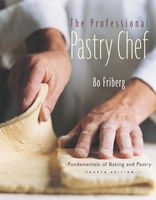Advertisement
Milk
By Bo Friberg
Published 1989
Milk, in addition to being a nourishing beverage, is one of the most frequently used ingredients in the bakeshop. It contributes to the gluten structure in bread dough and gives baked goods a nice crust, color, and flavor. Whole milk, fresh from the cow, contains almost 4 percent fat (usually referred to as butterfat) and 8 percent nonfat milk solids; the remaining 88 percent is water. When freshly drawn milk is left undisturbed for several hours, the fat portion rises to the surface, where it can be skimmed off and used as heavy cream or for making butter. The remaining milk is very rich and probably tastes closer to what we know as half-and-half than the milk we are used to drinking. This raw milk, even if kept cold, has to be consumed within approximately 48 hours and cannot be sold because it has not been pasteurized. Pasteurization is the process of heating the milk to 160°F(71°C) and holding it at that temperature for 15 seconds, which kills harmful bacteria. This process was invented by and named for


